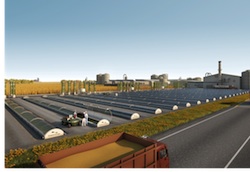Often times, it appears that people pit first generation biofuel technologies against second generation biofuel technologies. This leads me to ask the question, Why can’t we all get along? Well, now we can with the convergence of conventional ethanol technologies and emerging algal biomass technologies being developed by BioProcess Algae.
 BioProcess Algae is based in Portsmouth, Rhode Island and the company is designing, manufacturing and operating systems that enable controlled, economical cultivation of algal biomass using attached growth technology. According to CEO Tim Burns, the technology was developed through its water company, BioProcess H2O when they looked at the attached growth platform and how using their fixed films could be used as an effective way to grow algae. So in 2008 they formed BioProcess Algae, which is the sum of four companies: BioProcess H2O, Clarcor, Green Plains Renewable Energy, and NTR.
BioProcess Algae is based in Portsmouth, Rhode Island and the company is designing, manufacturing and operating systems that enable controlled, economical cultivation of algal biomass using attached growth technology. According to CEO Tim Burns, the technology was developed through its water company, BioProcess H2O when they looked at the attached growth platform and how using their fixed films could be used as an effective way to grow algae. So in 2008 they formed BioProcess Algae, which is the sum of four companies: BioProcess H2O, Clarcor, Green Plains Renewable Energy, and NTR.
Fast forward to 2011. Burns said the company has developed a three-prong business strategy to commercialize the technology. In partnership with Green Plains Renewable Energy (GPRE), they selected Shenandoah, Iowa to be the site where they prove out their technology at commercial scale. In a very simple terms, BioProcess Algae is using the plant’s CO2 emissions (aka flue gas) as a nutrient source to grow the algae. The plants also share waste water and waste heat.
Burns explained that the first phase began in October 2009 when they first integrated their Grower Harvester bioreactors directly to the plant’s CO2 exhaust gases. During this initial phase, they developed a set of metrics that included productivity and uptime targets. They exceeded all of their targets. Next, Phase 2 began. They have completed a 4,000 square foot facility that houses all the infrastructure needed to support their bioreactors including full process control and dewatering.
So what exactly does this sharing of resources mean for both technologies in terms of efficiency and production costs?
 “We’re improving the carbon footprint of the ethanol facility by utilization of their CO2,” said Burns. “And we’re getting an input for the growth of our algae through the co-location so we’re decreasing our cost structure and we’re not having to purchase the waste heat, the nutrients or the water, and the CO2 coming into our system.”
“We’re improving the carbon footprint of the ethanol facility by utilization of their CO2,” said Burns. “And we’re getting an input for the growth of our algae through the co-location so we’re decreasing our cost structure and we’re not having to purchase the waste heat, the nutrients or the water, and the CO2 coming into our system.”
In addition to fuel, BioProcess Algae is also looking at feed products. They’re doing feed trials this spring with Iowa State and the University of Nebraska specifically for the hen market and the cattle market.
One thing that Burns stresses is that this convergence of technologies is really about valuing carbon. “Once that first commercial facility is going, everyone looks at that stack differently going forward. Everyone looks at their greenhouse gas emissions as an opportunity not as a cost or as a nuisance,” said Burns.
Burns believes that co-locating advanced biofuels plants next to first generation biofuel plans is going to be the future. “Based on demographics and where the world is going, these are the solutions in feed and fuel that this country is going to have to take the leadership role to provide. We’re excited about our platform. We’re excited about getting that first facility up running in Shenandoah.”
You can listen to my full interview with Tim Burns, CEO of BioProcess Algae, here: BioProcess Algae - Bringing All Generations of Biofuels Together

